Frick, Germany
February 17, 2021
>> Globale Biolandbaufläche wächst weiter – Über 72,3 Millionen Hektar werden biologisch bewirtschaftet
>> La surface biologique mondiale ne cesse de croître – Plus de 72,3 millions d’hectares de surface agricole sont cultivés en bio
The latest data on organic farming worldwide was presented by the Research Institute of Organic Agriculture FiBL and IFOAM – Organics International at BIOFACH, the world’s leading trade fair for organic food. The statistics yearbook "The World of Organic Agriculture" was launched on Wednesday, 17 February 2021, from 4 to 4.45 pm (CET) at this year’s digital edition of BIOFACH eSpecial 2021.
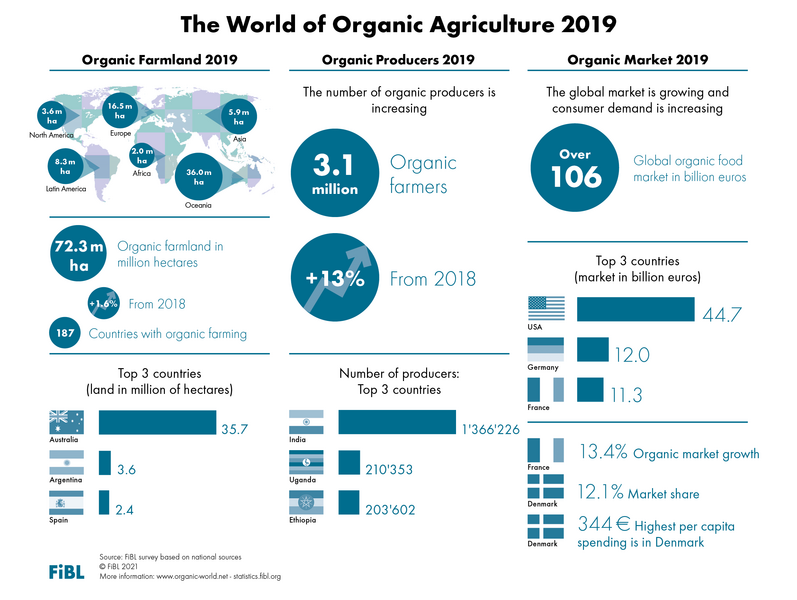
The infographic offers a great overview on organic farming worldwide.
According to the latest FiBL survey on organic agriculture worldwide, organic farmland increased by 1.1 million hectares, and organic retail sales continued to grow, as shown by the data from 187 countries (data as of the end of 2019). The 22nd edition of the study "The World of Organic Agriculture" published by FiBL and IFOAM – Organics International shows a continuation of the positive trend seen in the past years. This annual survey on organic agriculture worldwide is supported by the Swiss State Secretariat for Economic Affairs (SECO), the International Trade Centre (ITC), the Sustainability Fund of Coop Switzerland and NürnbergMesse, the organizers of the BIOFACH fair.
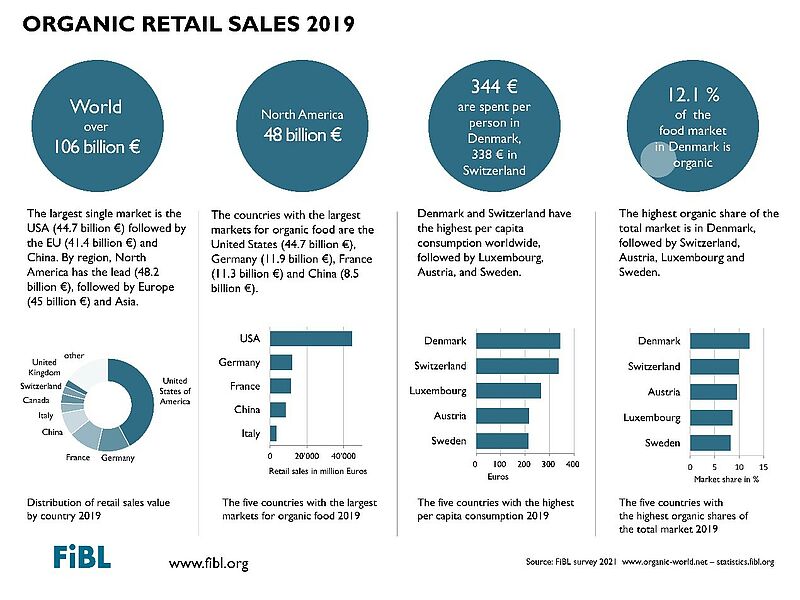
Switzerland and Denmark have the highest organic per capita consumption worldwide.
The global organic market continues to grow
The global market for organic food reached 106 billion euros in 2019. The United States is the leading market (44.7 billion euros), followed by Germany (12.0 billion euros) and France (11.3 billion euros). In 2019, many major markets continued to show strong growth rates; for example, the French market increased by more than 13 percent. Danish and Swiss consumers spent the most on organic food (344 and 338 euros per capita, respectively). Denmark had the highest organic market share, with 12.1 percent of its total food market.
3.1 million organic producers worldwide
In 2019, 3.1 million organic producers were reported. India continues to be the country with the highest number of producers (1’366’000), followed by Uganda (210’000), and Ethiopia (204’000). The majority of small-scale producers are certified in groups based on an internal control system.
Steady increase of organic farmland
A total of 72.3 million hectares were organically managed at the end of 2019, representing a growth of 1.6 percent or 1.1 million hectares compared to 2018. Australia has the largest organic agricultural area (35.7 million hectares), followed by Argentina (3.7 million hectares), and Spain (2.4 million hectares). Due to the large area of organic farmland in Australia, half of the global organic agricultural land is in Oceania (36.0 million hectares). Europe has the second largest area (16.5 million hectares), followed by Latin America (8.3 million hectares). The organic area increased in all continents compared to 2018, except in Asia (mainly due to a drop in organic farmland reported from China) and Oceania.
Ten percent or more of the farmland is organic in 16 countries
Globally, 1.5 percent of farmland is organic. However, many countries have far higher shares. The countries with the largest organic share of their total farmland are Liechtenstein (41.0 percent), Austria (26.1 percent) and São Tomé and Príncipe (24.9 percent). Some states in India are or aspire to be 100 % organic in the coming years. In sixteen countries, 10 percent or more of all agricultural land is organic.
Global organic statistics show ongoing engagement with transparency in the organic sector
"The global organic statistics have proven useful for international development cooperation programs and supporting strategies for organic agriculture and markets, and they are crucial for monitoring the impact of these activities. This publication shows our ongoing engagement with transparency in the organic sector", says Louise Luttikholt, IFOAM – Organics International Executive Director. Knut Schmidtke, Director of Research, Extension & Innovation of FiBL Switzerland, adds "The yearbook is an outstanding reflection of the level of trust people around the world have in organic agriculture and its importance for nutrition, the environment and sustainable development."
COVID-19 has resulted in a significant increase in demand for organic products in many countries but also challenges: "We expect to see the effect of the pandemic on the development of the sector with the 2020 data to be ready in a year’s time", says Helga Willer, who is in charge of the yearbook at FiBL.
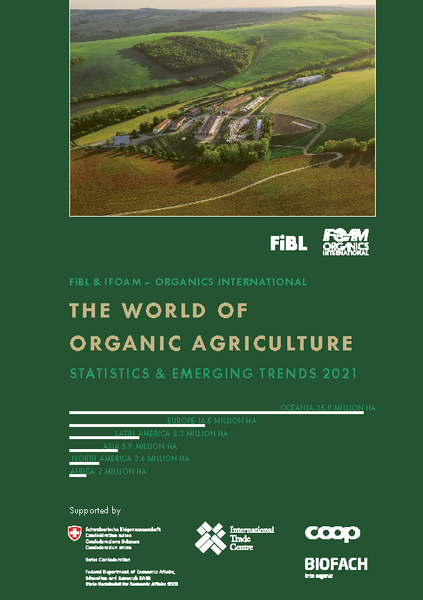
More information
How to order/download
The book can be ordered (30 euros + postage; affiliates of IFOAM – Organics International: 20 euros) or downloaded from the FiBL shop (order number 1150). Graphs and infographics can be downloaded at Organic-World.net.
Book citation
Willer, Helga, Jan Trávníček, Claudia Meier, Bernhard Schlatter (Eds.) (2021): The World of Organic Agriculture. Statistics and Emerging Trends 2021. Research Institute of Organic Agriculture FiBL, Frick, and IFOAM – Organics International, Bonn. Available at www.organic-world.net/yearbook/yearbook-2021.html.
Online database
Tables and interactive infographics with details on crops, markets, and international trade, as well as explanations about the data can be found on FiBL’s statistics website.
fibl.org: FiBL statistics website
Globale Biolandbaufläche wächst weiter – Über 72,3 Millionen Hektar werden biologisch bewirtschaftet
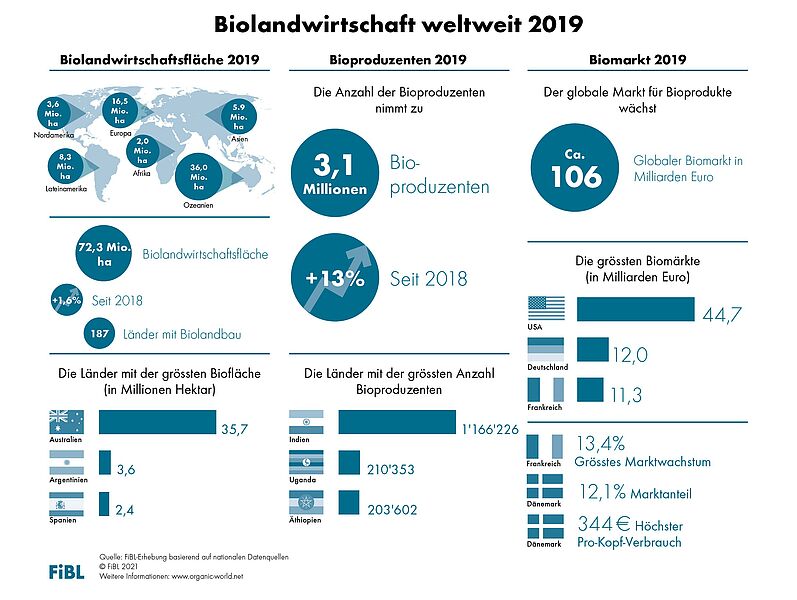
Diese Infografik bietet einen Überblick zu der Biolandwirtschaft weltweit.
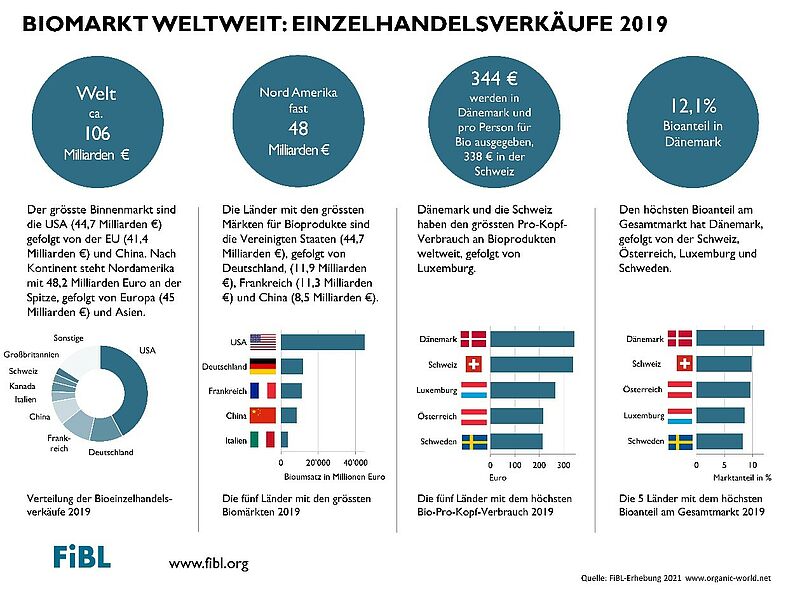
Dänemark und die Schweiz haben den den grössten Pro-Kopf-Verbrauch an Bioprodukten weltweit.
Das Forschungsinstitut für biologischen Landbau FiBL und IFOAM – Organics International präsentierten am 17. Februar 2021 die neuesten Zahlen zum Biolandbau weltweit auf der in diesem Jahr virtuell stattfindenden BIOFACH, der Weltleitmesse für Biolebensmittel (16.00 bis 16.45 Uhr).
(Frick, 17. Februar 2021) Der positive Trend der vergangenen Jahre setzt sich fort. Die Nachfrage nach Bioprodukten nimmt weiterhin zu und die Biofläche wächst, wie die Zahlen aus inzwischen 187 Ländern belegen. Das zeigt die jüngste Ausgabe der Studie "The World of Organic Agriculture". Dieses statistische Jahrbuch zum weltweiten Biolandbau geben das FiBL und der Weltdachverband des Biolandbaus IFOAM – Organics International gemeinsam heraus. Die Datenerhebung wird vom Schweizer Staatssekretariat für Wirtschaft SECO, dem International Trade Centre ITC, dem Coop Fonds für Nachhaltigkeit und der NürnbergMesse unterstützt.

The World of Organic Agriculture 2021 im FiBL-Shop
Informationen zu The World of Organic Agriculture 2021 auf Organic-World.net
Statistik-Webseite des FiBL
Präsentationen
Der globale Biomarkt wächst weiter
Der globale Markt für Bioprodukte belief sich 2019 auf über 106 Milliarden Euro. Die grössten Märkte sind die Vereinigten Staaten (44,7 Milliarden Euro), gefolgt von Deutschland (12,0 Milliarden Euro) und Frankreich (11,3 Milliarden Euro). 2019 verzeichneten wichtige Märkte ein zweistelliges Wachstum; so wuchs beispielsweise der französische Biomarkt um mehr als 13 Prozent. Am meisten gaben Dän*innen und Schweizer*innen 2019 für Biolebensmittel aus (344 respektive 338 Euro pro Kopf). Den höchsten Biomarktanteil wies Dänemark auf (12,1 Prozent).
3,1 Millionen Bioproduzentinnen und -produzenten
2019 gab es 3,1 Millionen Bioproduzentinnen und -produzenten weltweit: Die führenden Länder waren Indien (1'366'000), Uganda (210’000) und Äthiopien (204'000).
Erneutes Wachstum bei der Biolandwirtschaftsfläche
72,3 Millionen Hektar Landwirtschaftsfläche wurden Ende 2019 biologisch bewirtschaftet. Das sind 1,6 Prozent oder 1,1 Millionen Hektar mehr als 2018. Australien ist das Land mit der grössten Biolandbaufläche (35,7 Millionen Hektar), gefolgt von Argentinien (3,7 Millionen Hektar) und Spanien (2,4 Millionen Hektar).
Aufgrund der grossen Fläche in Australien liegt die Hälfte der globalen Biolandwirtschaftsfläche in Ozeanien (36,0 Millionen Hektar), gefolgt von Europa (16,5 Millionen Hektar) und Lateinamerika (8,3 Millionen Hektar). In allen Kontinenten nahm die Biolandwirtschaftsfläche zu, ausser in Asien (hauptsächlich aufgrund eines Rückgangs der biologischen Anbaufläche in China) und Ozeanien.
Sechzehn Länder mit einem Bioflächenanteil von mindestens 10 Prozent
Weltweit werden 1,5 Prozent der Landwirtschaftsfläche biologisch bewirtschaftet. Zahlreiche Länder haben jedoch einen viel höheren Anteil. Die Länder mit dem höchsten Bioanteil an der gesamten Landwirtschaftsfläche sind Liechtenstein (41,0 Prozent), Österreich (26,1 Prozent) sowie São Tomé und Príncipe (24,9 Prozent). In 16 Ländern werden mindestens 10 Prozent der Landwirtschaftsfläche biologisch bewirtschaftet.
Globale Biolandbaustatistik zeigt anhaltendes Engagement für Transparenz im Biosektor auf
"Die globale Biolandbau-Statistik ist eine nützliche Grundlage für Programme der Entwicklungszusammenarbeit und insbesondere für Strategien zur Förderung des ökologischen Landbaus und seiner Märkte. Anhand der Daten kann die Wirkung entsprechender Aktivitäten abgelesen werden. Die Publikation dokumentiert unser stetiges Engagement, die Entwicklungen im Biosektor aufzuzeigen", erklärt Louise Luttikholt, Exekutivdirektorin von IFOAM - Organics International. Knut Schmidtke, Direktor für Forschung, Extension & Innovation am FiBL Schweiz ergänzt: "Das Jahrbuch spiegelt das weltweite Vertrauen der Menschen in den biologischen Landbau und dessen Bedeutung für die Ernährung, die Umwelt und eine nachhaltige Entwicklung herausragend wider".
COVID-19 hat in vielen Ländern zu einem deutlichen Anstieg der Nachfrage nach Bioprodukten geführt: "Wir erwarten, dass wir die Auswirkungen der Pandemie auf den Biosektor mit den Daten für 2020 sehen, die in einem Jahr vorliegen werden", sagt Helga Willer, die die Herausgabe des statistischen Jahrbuchs am FiBL verantwortet.
Weiterführende Informationen
Bestellung und Download
Die Druckversion (30 Euro + Versand; IFOAM-Mitglieder 20 Euro) der Studie kann über den FiBL-Shop (Shop-Nummer 1150) bestellt werden. Dort und auf Organic-World.net steht das Buch auch als kostenloser Download zur Verfügung. Grafiken, Karten und Infografiken sind ebenfalls auf Organic-World.net abrufbar.
Zitierhinweis
Willer, Helga, Jan Trávníček, Claudia Meier and Bernhard Schlatter (Hrsg.) (2021): The World of Organic Agriculture. Statistics and Emerging Trends 2021. Forschungsinstitut für biologischen Landbau FiBL, Frick, und IFOAM – Organics International, Bonn. Abrufbar unter www.organic-world.net/yearbook/yearbook-2021.html
Online-Datenbank
Tabellen und interaktive Grafiken mit Zahlen zu Flächen, Märkten und Produzenten können auf der FiBL-Statistikseite abgerufen werden.
fibl.org: FiBL-Statistikseite